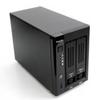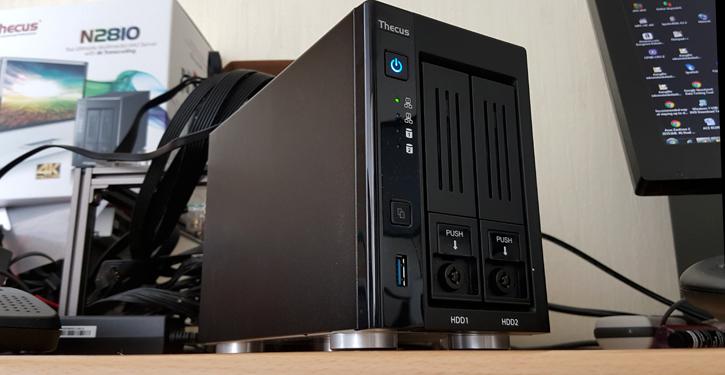Final Words & Conclusion
Final words and conclusion
The step upwards with the new and improved Thecus OS, now at build 7, has been massive. Even if you have an older series Thecus NAS, if you can upgrade to new firmware you should as it will feel like you own a new NAS. The N2810 as tested today as such is complemented by the new OS, making it a viable and fast NAS. I do have to state this though, the N2810 is selling for close to 299 EURO/USD and for that money the competition offers quad-core solutions opposed to this dual-core product. Last week Thecus launched the N2810PLUS model with an improved processor (quad-core celeron) as well as memory doubled up towards 4 GB. With that release in mind it kind of baffles me that Thecus sent out this dual-core/2GB N2810 version and not the new PLUS model. Realistically, even with the dual-core processor and that 2 GB of (upgradable) memory the NAS is plenty fast for your SOGO and centralized storage needs. Even at 2 HDD trays you could do a RAID solution with some kind of mirroring / striping combo however at 2 HDDs your choices are limited. Performance wise, RAID at a Gigabit hookup is not that relevant anymore as HDDs pass the 100 MB/s marker these days as well.
My main worry is your HDTV and full HD playback would be limited by the 2GB of system memory, however during playback we reached close to 2GB but did not reach it, so that remains well balanced. The XBMC / Kodi implementation on this unit works well, we recommend 1080p at best but Ultra HD can be played as well as the Kodi version used has been optimized and hardware accelerates your content through the IGP of the processor, that also gives low 10~20% CPU loads as the IGP is doing all the decoding. A NAS for HTPC usage remains limited but granted it does work good enough. Combined with the apps the unit offers the sky is the limit when it comes to running your own webserver based on MySQL. Stuff like joomla etc. would not have a problem with this, which really is a small server platform. On the media side of things there are sharing/streaming apps like Plex available so that you can stream content towards the player on your TV or, alternatively, Media box. Downloading wise all your Usenet and Bittorent apps are covered as well. Both offering good download speeds with this NAS.
Overall usage
This unit performs at proper numbers, 99.99% of you guys will have a Gigabit switch and a Gigabit jack on your PC. After QoS and error correction, that is how fast this NAS can be. We had no issues passing 100 MB/sec on our reads and writes, though the Anvil tests showed slower read performance (but this test does apply complex workloads intended for SSDs). Obviously your HDD can be slower than the performance we just mentioned. Especially with small files (heaps of them) a 5400 RPM 6TB HDD will be slow. It's the HDD IO and cache capability, not the NAS, so please keep that in mind. Lovely to see however is that you can mount an SSD and enable SSD caching. This way your read/write/IO/iops performance will dramatically increase, but at the cost of an SSD and one HDD tray of course.
The PLUS model got an upgrade to a quad-core processor, this 'regular' N2810 unit however has one simple 5W Intel Celeron N3050 1.6GHz that can boost up towards 2.16GHz on both cores. Honestly, it's plenty fast for normal NAS operation and it's very energy friendly as well. That quad-core PLUS model WILL use more power and remember, these units run 24/7/365. If our 2-bay model would use 8 Watts on average over the year that would cost ((8/1000) x (24 x 365)) x 0.21 Cents = 14.71 Euro per year to run (based on Dutch energy prices). And that definitely is energy friendly, good for the environment and good for your wallet. One gripe though, I would have liked to have seen this unit with 4 GB of memory over the standard 2 GB. With the two trays available you could insert say 8 TB HDDs in JBOD, that's stilll a nice 16TB of data storage man. A notable mention as well is that the OS supports multiple file-systems for local storage like the always popular EXT4 system, XFS and Btrfs are supported as well. The Btrfs filesystem has options like pooling, checksums, and other features. However, performance with Btrfs will be slower opposed to XFS and EXT4. But hey, choices are good, right?
Performance
We reached high transfer speeds over our Gigabit Ethernet connection and though Ethernet will always bring in some performance and lag issues over a network connection, it's plenty fast for all your activities. With large files and a fast enough HDD over a Gigabit connection you will reach 100~115 MB/sec on reads and writes. So for this type of connection, really it can hardly go any faster. Even for the GUI and OS side of things we can say that the NAS is responsive and very fast. The usage of this processor also makes your applications fast and responsive, anything Apache and MySQL related for home usage will function fine as well. Yeah, for a unit that draws roughly 10 Watts (average based on two HDDs) I am still a little surprised.
Flexibility
You'll have your FTP server, you can upload images and music, make slideshows out of them and show it on the web server of the device or watch photos and videos with the help of a software suite on even your smartphone. You can stream DLNA (Digital Living Network Alliance) and this NAS can be automatically discovered by Digital Media Players (DMP), Digital Media Renders (DMR) and Digital Media Controllers (DMC) allowing pictures, music and video to be shared instantly at any time at home. All DLNA Certified Devices are capable of streaming content instantly from this NAS. You can share files over the internet if you wanted to, and the list goes on and on. Keep in mind though that everything on this box is targeted at consumers and small business users (SOHO). Though you can access the WEB directory and make your own website, control and configuration over say the MySQL server we do warn you to take security measures. Make sure you secure your public files with proper Unix/Linux permissions. Thus at least a CHMOD 755 on Directories and preferably 644 on files. You can log in to the box through SSH.
A fun extra feature is the HDMI connector and thus (Ultra) HD television compatibility. On Ultra HD you are limited to that HDMI connector (1.4a) though and thus are stuck at 30hz. Full HD 1080P (60Hz) is supported. From there onwards just connect a keyboard and mouse to one of the USB ports on the NAS and in the home screen you can access the admin interface of this NAS. Obviously XBMC is your choice of weaponry here.
Energy Efficiency
We tested performance on this unit with an SSD so that we could be certain the storage unit would never be a bottleneck in terms of measuring storage performance. This SSD uses roughly 3.5 Watts. The traditional HDD these days uses roughly 5 Watts. If you use one 8TB HDD for example, this unit would still hover in or at the 10 Watt range under full load with one HDD, a reasonable number TBH. That said, in idle and low usage circumstances the NAS unit uses roughly 10 Watts with two HDDs and under load (HDD usage both units) and playing back video you'll reach the 20 Watt marker, which is still very low.
Final words and verdict
The NAS channel is getting more and more saturated and that is driving prices downwards and specification upwards. Three years ago a NAS like shown today would cost you over 500 euro/usd. The unit as tested right now costs 299 euro/USD. While writing this article a press release was posted at Thecus, this N2810 model will get a PLUS version with an Intel Celeron N3150 Quad Core processor and 4 GB of DDR3 RAM. That is the model you should get at the 300 euro/USD marker TBH. Regardless, this dual-core/2 GB version runs absolutely fine. However, that competition is driving specs upwards due to differentiation in the market, you as a consumer or small business owner will benefit from that steep competition. The new ThecusOS 7 software suite looks great, it's responsive and offers more than enough features. The days when a NAS unit was just a file-server are gone, I like to call it centralized storage. These boxes are fully fledged file serving servers with a plethora of applications and functionality. The Thecus N2810 with the new OS is definitely one of the more versatile NAS units available on the market that can keep up with names like QNAP and AsusTOR. The overall performance is good, it is Gigabyte Ethernet compatible. At the 300 EURO/USD marker it is not cheap for a dual-core product with 2GB - though we feel the price is fair for what you get, and you are receiving a proper SOHO server. As such we'll recommend the Thecus N2810 for the SOHO and consumer side of the market, it is a very handy NAS with good performance and extensive features that you may expect from a NAS unit anno 2016, and the ThecusOS 7 firmware does make a nice difference. Recommended for sure, but keep an eye on that new PLUS model okay?
Give Thecus a visit here.
- Sign up to receive a notice when we publish a new article
- Or go back to Guru3D's front page.



